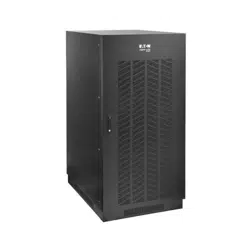Loading ...
Loading ...
Loading ...

6
2. Important Safety Instructions
• Wiring and assembly should be performed by trained, qualied electricians only. Refer to the UPS unit’s Owner’s Man-
ual for wire sizing.
2.3 Battery Warnings
• The battery cabinet requires routine maintenance by qualied, knowledgeable service personnel familiar with its
operation. All required precautions should be taken prior to opening the cabinet for any reason. Keep unauthorized
personnel away from batteries.
• The battery cabinet contains valve-regulated recombinant lead-acid (VRLA) batteries. Do not attempt to add water to
these batteries or sample the electrolyte specic gravity.
• VRLA batteries can contain an explosive mixture of hydrogen gas. DO NOT SMOKE when near batteries. DO NOT cause
ames or sparks near batteries. Discharge static electricity from body before touching batteries. DO NOT open or
mutilate batteries—released electrolyte is harmful to the skin and eyes and may be toxic. DO NOT dispose of batteries
in a re—they may explode.
• Batteries present a risk of electrical shock and burns from high short-circuit current. Battery connection or
replacement should be performed only by qualied service personnel observing proper precautions. Use tools with
insulated handles. Remove watches, rings or other metal objects. Wear rubber gloves and boots. Do not short or
bridge the battery terminals with any object. Do not lay tools or metal parts on top of batteries.
• Replace batteries with equivalent batteries (same number and type).
• The batteries are recyclable. Refer to local codes for disposal requirements. Do not dispose of batteries except
through approved channels in accordance with all applicable local, state and national regulations.
• Do not connect or disconnect batteries when the UPS system is operating from the battery supply or when the unit is
not in bypass mode. Disconnect the charging source prior to connection or disconnecting battery terminals.
• If the charging source remains o for an extended period of time, it should be turned on periodically to allow the
batteries to recharge. The charging source should be turned on and the batteries should be recharged at least one
uninterrupted 24-hour period every 3 months. Failure to recharge the batteries periodically may cause permanent
battery damage.
• Allow batteries to charge uninterrupted for 24 hours after installation.
Note on Labeling
These symbols may appear on the product label:
V : DC Voltage
: Ground
+: Battery Positive
– : Battery Negative
Refer to the product label for model numbers, voltage ratings and other important information.
2.4 Standards Compliance
• UL 1778, CSA-C22.2 No. 107.3-14 (3rd Ed)
• ISTA B (Transport, Vibration, Tilt)
Loading ...
Loading ...
Loading ...
